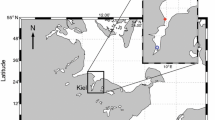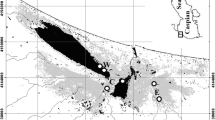Abstract
The diet of Japanese eels, Anguilla japonica, was investigated using stomach content and stable isotope analyses. Stable isotope enrichment of carbon and nitrogen (Δδ13C and Δδ15N) was first estimated for A. japonica by comparing the isotopic signatures (δ13C and δ15N) of reared eels to that of their food. The estimated isotope enrichment was then applied to the diet estimation of A. japonica in the Kojima Bay-Asahi River system, Japan, combined with conventional stomach content analysis. Stable isotope enrichment varied among tissues, from 0.2‰ to 0.8‰ for carbon and from 1.3‰ to 2.1‰ for nitrogen. Nitrogen isotope enrichment of A. japonica muscle estimated in this study was 2.1‰, which was different from the previously reported mean δ15N enrichment of several animals of 3.4‰. These results indicate that isotope-based diet estimations for A. japonica need to use species- and tissue-specific values of isotope enrichment. In the diet analysis, stomach contents and stable isotopes revealed that (1) A. japonica appear to usually feed on a single type of prey species in each feeding session, (2) principal prey species were mud shrimp, Upogebia major, in brackish Kojima Bay and crayfish, Procambarus clarkia, in the Asahi River, (3) A. japonica in Kojima Bay primarily depend on the pelagic food web as a carbon source due to mud shrimp being filter feeders and eels in the Asahi River primarily depend on the littoral food web. Based on these results and the recently reported eel movements between Kojima Bay and the Asahi River, it appears that A. japonica can adapt to various feeding environments as opportunists, but also utilize the food resources by targeting a single type of prey species during a single feeding session.


Similar content being viewed by others
References
Anonymous (1958–2008) Annual statistics on fishery and aquaculture production (in Japanese). Statistics Department, Ministry of Agricu1ture, Forestry and Fisheries, Japan
Arai T, Kotake A, Ohji M, Miller MJ, Tsukamoto K, Miyazaki N (2003) Occurrence of sea eels of Anguilla japonica along the Sanriku coast of Japan. Ichthyol Res 50:78–81
Barr B (1997) Food habits of the American Alligator, Alligator mississippiensis, in the southern Everglades. Ph.D. Dissertation. University of Miami. Coral Gables
Begon M, Harper JL, Townsend CR (1996) Ecology: individuals, populations and communities, 3rd edn. Blackwell, Oxford
Chow S, Kurogi H, Katayama S, Ambe D, Okazaki M, Watanabe T, Ichikawa T, Kodama M, Aoyama J, Shinoda A, Watanabe S, Tsukamoto K, Miyazaki S, Kimura S, Yamada Y, Nomura K, Tanaka H, Kazeto Y, Hata K, Handa T, Tawa A, Mochioka N (2010) Japanese eel Anguilla japonica do not assimilate nutrition during the oceanic spawning migration: evidence from stable isotope analysis. Mar Ecol Prog Ser 402:233–238
Daverat F, Tomas J (2006) Tactics and demographic attributes in the European eel Anguilla anguilla in the Gironde watershed, SW France. Mar Ecol Prog Ser 307:247–257
Dekker W (2004) What caused the decline of the Lake IJsselsmeer eel stock after 1960. ICES J Mar Sci 61:394–404
Dörner H, Skov C, Berg S, Schulze T, Beare DJ, Velde VdG (2009) Piscivory and trophic position of Anguilla anguilla in two lakes: importance of macrozoobenthos density. J Fish Biol 74:2115–2131
Folch J, Lees M, Sloanestanley GH (1957) A simple method for isolation and purification of total lipids from animal tissues. J Biol Chem 226:497–509
Gearing JN (1991) The study of diet and trophic relationships through natural abundance 13C. In: Coleman DC, Fry B (eds) Carbon isotope techniques. Academic, San Diego, pp 201–218
Gutiérrenz-Yurrita PJ, Sancho G, Bravo MÁ, Baltanás Á, Montes C (1998) Diet of the red swamp crayfish Procambarus clarkii in natural ecosystems of the Dońana national park temporary fresh-water marsh (Spain). J Crust Biol 18:120–127
Hobbs HH III, Jass JP, Huner JV (1989) A review of global crayfish introductions with particular emphasis on two North American species (Decapoda, Gambaridae). Crustaceana 56:299–316
Hyslop EJ (1980) Stomach contents analysis - a review of methods and their application. J Fish Biol 17:411–429
Jellyman DJ (1989) Diet of two species of freshwater eel (Anguilla spp.) in Lake Pounui, New Zealand. NZ J Mar Freshwat Res 23:1–10
Jessop BM, Shiao JC, Iizuka Y, Tzeng WN (2002) Migratory behaviour and habitat use by American eels Anguilla rostrata as revealed by otolith microchemistry. Mar Ecol Prog Ser 233:217–229
Kaifu K, Tamura M, Aoyama J, Tsukamoto K (2010) Dispersal of yellow phase Japanese eels Anguilla japonica after recruitment in the Kojima Bay-Asahi River system, Japan. Environ Biol Fish 88:273–282
Kotake A, Okamura A, Yamada Y, Utoh T, Arai T, Miller MJ, Oka H, Tsukamoto K (2005) Seasonal variation in the migratory history of the Japanese eel Anguilla japonica in Mikawa Bay, Japan. Mar Ecol Prog Ser 293:213–225
Lammens EHRR, Visser JT (1989) Variability of mouth width in European eel, Anguilla anguilla, in relation to varying feeding conditions in three Dutch lakes. Environ Biol Fish 26:63–75
Lammens EHRR, De Nie HW, Vijverberg J, van Densen WLT (1985) Resource partitioning and niche shifts of bream (Abramis brama) and eel (Anguilla anguilla) mediated by predation of smelt (Osmerus eperlanus) on Daphnia hyalina. Can J Fish Aquat Sci 42:1342–1351
Lin YJ, Luzys L, Shiao JC, Iizuka Y, Tzeng WN (2007) Growth differences between naturally recruited and stocked European eel Anguilla anguilla from different habitats in Lithuania. J Fish Biol 71:1773–1787
Matsui I (1972) Eel biology (in Japanese). Kouseisha Kouseikaku, Tokyo
Morrison WE, Secor DH, Piccoli PM (2003) Estuarine habitat use by Hudson River American eels as determined by otolith strontium:calcium ratios. In: Dixon DA (ed) Biology, management and protection of catadromous eels. Symposium 33, American Fisheries Society, Bethesda, MD, pp 87–100
Mukai H, Koike I (1984) Behavior and respiration of the benthic burrowing shrimps Upogebia major (De Haan) and Callianassa japonica (De Haan). J Crust Biol 4:191–200
Post DM (2002) Using srable isotopes to estimate trophic position: models, methods, and assumptions. Ecology 83:703–718
Tesch FW (1977) The eel biology and management of anguillid eels. Chapman and Hall, London
Tesch FW (2003) The eel, 3rd edn. Blackwell, Oxford
Tinbergen L (1960) The natural control of insects in pinewoods. 1: factors influencing the intensity of predation by songbirds. Arch Neerl Zool 13:266–336
Tsukamoto K (1990) Recruitment mechanism of the eel, Anguilla japonica, to the Japanese coast. J Fish Biol 36:659–671
Tsukamoto K (1992) Discovery of the spawning area for Japanese eel. Nature 356:789–791
Tsukamoto K (2006) Spawning of eels near a seamount. Nature 439:929–929
Tsukamoto K, Arai T (2001) Facultative catadromy of the eel Anguilla japonica between freshwater and seawater habitats. Mar Ecol Prog Ser 220:265–276
Tsukamoto K, Nakai I, Tesch WV (1998) Do all freshwater eels migrate? Nature 396:635–636
Tsukamoto K, Aoyama J, Miller MJ (2002) Migration, speciation, and the evolution of diadoromy in anguillid eels. Can J Fish Aquat Sci 59:1989–1998
Tsukamoto K, Aoyama J, Miller MJ (2009) Status of the Japanese eel: resources and recent research. In: Casselman JM, Cairns DK (eds) Eels at the edge: science, status, and conservation concerns. American Fisheries Society, Symposium 58 Bethesda, Maryland, pp 21–35
Tsukamoto K, Chow S, Otake T, Kurogi H, Mochioka N, Miller MJ, Aoyama J, Kimura S, Watanabe S, Yoshinaga T, Shinoda A, Kuroki M, Oya M, Watanabe T, Hata K, Ijiri S, Kazeto Y, Nomura K, Tanaka H (2011) Oceanic spawning ecology of freshwater eels in the western North Pacific. Nat Commun. doi:10.1038/ncomms1174
Vander Zanden MJ, Rasmussen JB (2001) Variation in δ 15N and δ 13C trophic fractionation: implications for aquatic food web studies. Limnol Oceanogr 46:2061–2066
Yokouchi K, Aoyama J, Oka HP, Tsukamoto K (2008) Variation in the demographic characteristics of yellow-phase Japanese eels in different habitats of the Hamana Lake system, Japan. Ecol Freshw Fish 17:639–652
Yokouchi K, Sudo R, Kaifu K, Aoyama J, Tsukamoto K (2009) Biological characteristics of silver-phase Japanese eels, Anguilla japonica, collected from Hamana Lake, Japan. Coast Mar Sci 33:54–63
Yokoyama H, Tamaki A, Koyama K, Ishii Y, Shimoda K, Harada K (2005) Isotopic evidence for phytoplankton as a major food source for macrobenthos on an intertidal sandflat in Ariake Sound, Japan. Mar Ecol Prog Seri 304:101–116
Acknowledgments
We thank Mr. and Mrs. Shimizu of Shimizu-Suisan and Mr. Omoto of Momotaro-Suisan for their voluntary help during our eel sampling, and the Fisheries Cooperatives of Kojima Bay, Fisheries Cooperatives of the South Asahi River and the Fisheries Division of Okayama Prefecture for cooperation. We also thank Irago Institute Co., Ltd. for kindly supplying us eel samples for stable isotope analysis. Assistance with the paper by MJ Miller was highly appreciated. This work was partly supported by the Sasakawa Scientific Research Grant from The Japan Science Society.
Author information
Authors and Affiliations
Corresponding author
Rights and permissions
About this article
Cite this article
Kaifu, K., Miyazaki, S., Aoyama, J. et al. Diet of Japanese eels Anguilla japonica in the Kojima Bay-Asahi River system, Japan. Environ Biol Fish 96, 439–446 (2013). https://doi.org/10.1007/s10641-012-0027-0
Received:
Accepted:
Published:
Issue Date:
DOI: https://doi.org/10.1007/s10641-012-0027-0




